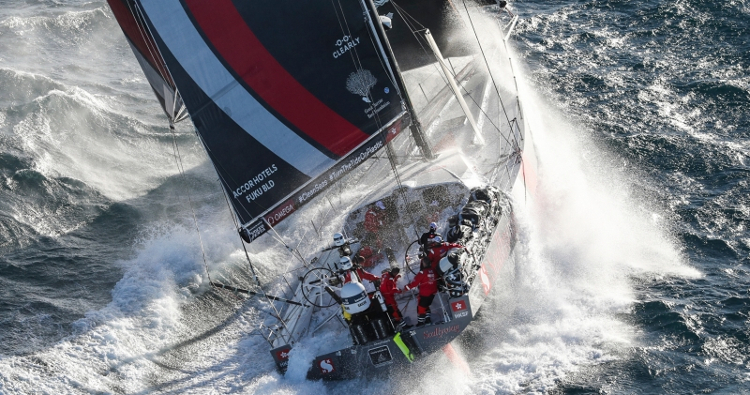
The Volvo Ocean Race is an offshore sailboat race that sends competitors on a full circumnavigation of the planet. Formerly known as the Whitbred Round the World Race, this is easily one of the toughest sailboat races on the planet - the 2017-2018 edition of the race will cover 45,000 nautical miles, across four oceans, touching six continents and 12 cities, all in just 7 months. Below you'll find a quick introduction to what makes the race so special and why it's so much fun to follow.
The Boat
The Volvo Ocean 65. Designed by Farr Yacht Design in Annapolis, MD, the Volvo 65 is a collection of large, impressive numbers:
- Made primarily of carbon fiber, this boat is incredibly light for its size, weighing in at only 27,500lbs.
- For comparison, a J/65 weighs 50,000lbs and a Swan 65 (which is the first boat to ever win the Whitbred, by the way) tips the scales at nearly 70,000lbs.
- It has twin rudders, twin daggerboards, and a single keel that can swing up to 40-degrees side to side for increased stability.
- The carbon fiber mast reaches 99.4 feet into the sky and is responsible for holding up a:
- 1,750 sqft mainsail
- 1,400 sqft jib
- 3,300 sqft Code Zero
- 4,500 sqft A3 spinnaker
- In total, each boat is carrying eight sails at any given time, giving them the ability to push these boats to their maximum potential at any given time. Speaking of the maximum potential...
- The boat can touch 11kts upwind and up to 30 knots(!!!) downwind.
- A full campaign costs somewhere in the neighborhood of $12,000,000 to $18,000,000 USD.
- It takes 7 months and 36000 man hours to build, assemble, and paint a Volvo Ocean 65. There are 120 boatbuilders who work with 70 suppliers to outfit the boat.
Take a look at what these boats can do when they're going at full speed -- this footage is from Lisbon, Spain as the boats made their way out to the Atlantic for the 2nd Leg of the 2017-2018 Volvo Ocean Race.
The Route
The race has always taken sailors on a full lap of the planet, but the exact route has changed over time. During the first edition of the race in 1973 there were just four legs that started and finished in England as the crews endeavored to follow in the footsteps of the old square rigger ships that carried cargo around the world.
The race expanded to six legs in the 1990s and is now up to 10 legs for the 2017-2018 race. With the additional legs comes even more distance to sail -- the race now clocking in at over 45,000nm. The sailors will leave from Alicante, Spain this year and finish at The Hague, Netherlands. Those of you with access to a globe will have realized that now takes them on more than a full lap of the planet!
Creature Comforts On-Board
For once, old timers can't say "it was so much harder back in my day".
Like the route, life on-board has changed during the race. In 1973, the winning boat was one of the few yachts to have a freezer on board, allowing the crew to dine on steaks, hamburgers and chicken each day, washed down with plentiful supplies of beer and carefully selected wine - the crew reckoned they got through six bottles of wine each day. There was also had an eight track stereo system, 100 tapes, and a pair of headphones.
As you might imagine, things have changed. The meals are all freeze-dried (though there are an assortment of tasty, high-calorie snacks to keep the sailors going) and the comforts down below are… sparse. There’s a head, some bunks, cold and cold running water, some small fans that mostly just cough out hot air when the boats are near the Equator, a nav station, and no windows. To keep weight down the crew will often only carry one or two changes of clothes for a leg, some of which can take 20+ days. Sounds fun, right?
How to Follow Along (other than staying tuned to SpinSheet!)
One of the great additions to modern versions of the Volvo Ocean Race are the dedicated Media Crew Members. All they can do is help with the preparation of meals and spend their days taking video and photos as the crews push the boats 24/7 through every condition that you can think of. The results of their work are, quite frankly, spectacular.
Media Crew Members are constantly sending new material back to Volvo Race Control that gets posted on YouTube, Twitter, Instagram, or their website and it's always worth following.




